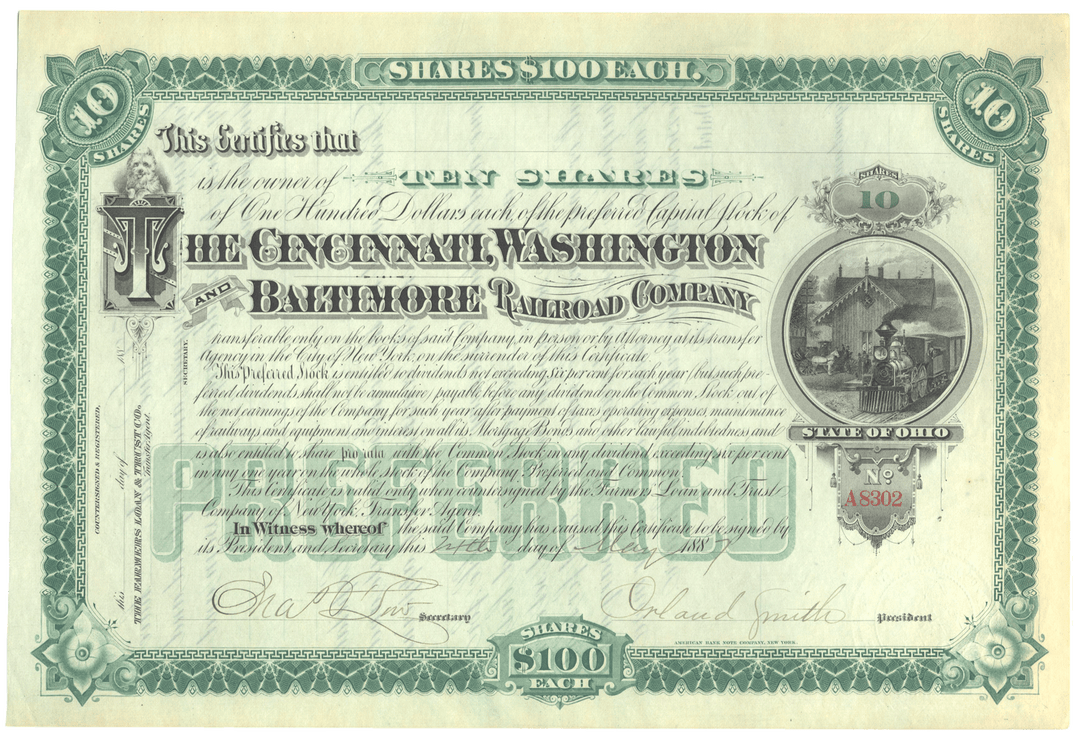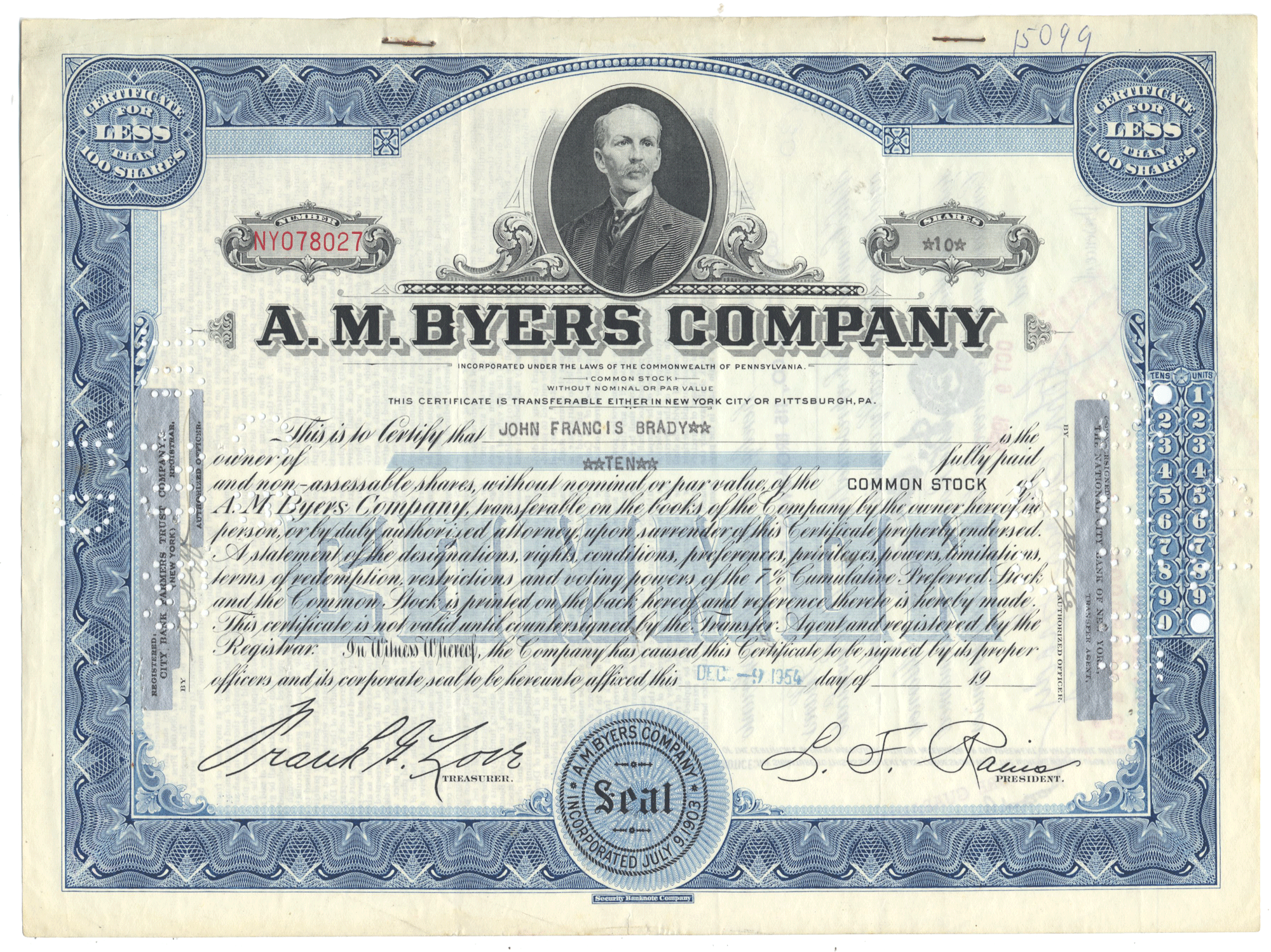
Cincinnati, Washington and Baltimore Railroad Company (Signed by Orland Smith)
- Guaranteed authentic document
- Orders over $75 ship FREE to U. S. addresses
Product Details
Company
Cincinnati, Washington and Baltimore Railroad Company
Certificate Type
Preferred Stock
Date Issued
May 24, 1887
Canceled
Yes
Printer
American Bank Note Company
Signatures
Hand signed
Approximate Size
11 1/4" (w) by 7 1/2" (h)
Images
Show the exact certificate you will receive
Guaranteed Authentic
Yes
Additional Details
Signed by Orland Smith
Historical Context
The Marietta & Cincinnati Railroad was originally established in 1845 as the Belpre & Cincinnati Railroad. It was to connect Belpre, Ohio with Cincinnati, Ohio. The company overseeing construction of the line chose to send the railroad line from Wheeling, Virginia (modern-day West Virginia) to Marietta, Ohio, rather than through Belpre. The Marietta & Cincinnati Railroad went bankrupt in 1857 after completing only 157 miles of track.
Although the original company collapsed financially, construction began again on the Marietta & Cincinnati Railroad. By 1866, the line had reached Cincinnati, crossing Ohio through the south-central part of the state. The line prospered for the next ten years or so, as the iron producing regions of Ohio in Jackson and Hocking Counties now had an easier means of shipping the iron ore to Cincinnati. Before the Marietta & Ohio's completion, most iron ore produced in Ohio came from the southern part of the state near the Ohio River.
The line also provided southern Ohio residents a quicker means of traveling to Cincinnati. Numerous suburbs were established on Cincinnati's outskirts, and residents rode trains to work in the downtown portion of the city. Later, the Baltimore & Ohio Railroad purchased the Marietta & Cincinnati line. The Marietta & Cincinnati became known as the Cincinnati, Washington & Baltimore Railroad at this point. This line remained in operation as part of the Baltimore & Ohio Railroad system until the Baltimore & Ohio shifted its operations to a track along the Ohio River. The Marietta & Cincinnati line remained in use for most of the twentieth century.
Orland Smith

Orland Smith (May 2, 1825 – October 3, 1903) was a railroad executive and a brigade commander in the Union Army during the American Civil War. In 1864, he led a spirited bayonet charge during the Battle of Wauhatchie that took a significant Confederate position on a hill that now bears his name.
Smith was born in New England in Lewiston, Maine. He was educated in the local schools and became a railroad agent, serving as station manager at Lewiston until 1852 when he moved to Ohio. He became an official of the Marietta and Cincinnati Railroad and settled in Chillicothe, Ohio. When the railroad fell into financial difficulties, he was appointed receiver. Smith was a lieutenant and commander of a militia company known as the "Chillicothe Greys."
With the outbreak of the Civil War, Smith joined the Union army and became the colonel of the 73rd Ohio Infantry, a regiment that was raised in Chillicothe in November 1861 and trained at nearby Camp Logan. Among his volunteer soldiers was Pvt. George Nixon III, the great-grandfather of future President Richard Nixon. Smith and his regiment saw action in western Virginia, fighting at the Battle of McDowell and the Battle of Cross Keys. During the late summer, as a part of the Army of Virginia, the 73rd OVI fought at the Second Battle of Bull Run near Manassas, Virginia.
Smith assumed brigade command in the XI Corps on October 25, 1862, but he did not participate in the Battle of Chancellorsville. He returned to his command shortly before the Gettysburg Campaign, after Brig. Gen. Francis C. Barlow, who had led the brigade at Chancellorsville, was given command of the 1st Division on May 24, 1863. Smith's men held Cemetery Hill on the first day of the Battle of Gettysburg at the orders of MG Oliver O. Howard, and provided an anchor for the retreating Federal soldiers. On the second day, three of Smith's regiments were engaged in heavy skirmishing in front of Cemetery Hill, and the 33rd Massachusetts, deployed between East Cemetery Hill and a knoll on the McKnight farm, helped repulse an evening attack by Col. Isaac E. Avery's North Carolina brigade.
Smith's Brigade was sent to the Western Theater in the autumn of 1863 along with the rest of the XI Corps. During the Chattanooga Campaign, Smith led his brigade in the Army of the Cumberland in a successful bayonet assault up a steep hill that now bears his name (Smith's Hill) during the Battle of Wauhatchie. In the army reorganization later that year, his brigade was disbanded and Smith returned on January 3, 1864 to the command of the 73rd OVI. He resigned his colonelcy on February 17, 1864. In the omnibus promotions at the close of the Civil War, Smith was appointed a brevet brigadier general dating from March 13, 1865.
After the war, he returned to his career as a railroad officer and became President of the Cincinnati, Washington and Baltimore Railroad and later, First Vice President of the Baltimore and Ohio Railroad. From 1884 to 1899 he was President of the Columbus and Cincinnati Midland Railroad.
Smith died in Chicago, Illinois. He is buried in Green Lawn Cemetery in Columbus, Ohio.
Related Collections
Additional Information
Certificates carry no value on any of today's financial indexes and no transfer of ownership is implied. All items offered are collectible in nature only. So, you can frame them, but you can't cash them in!
All of our pieces are original - we do not sell reproductions. If you ever find out that one of our pieces is not authentic, you may return it for a full refund of the purchase price and any associated shipping charges.





